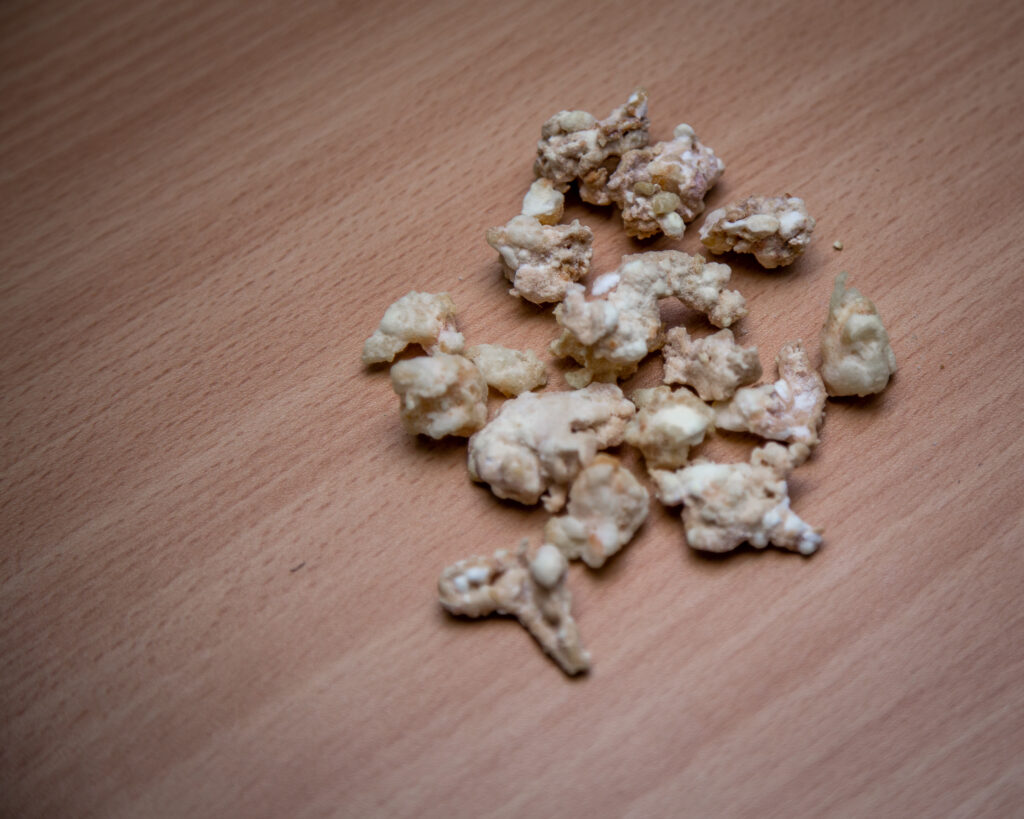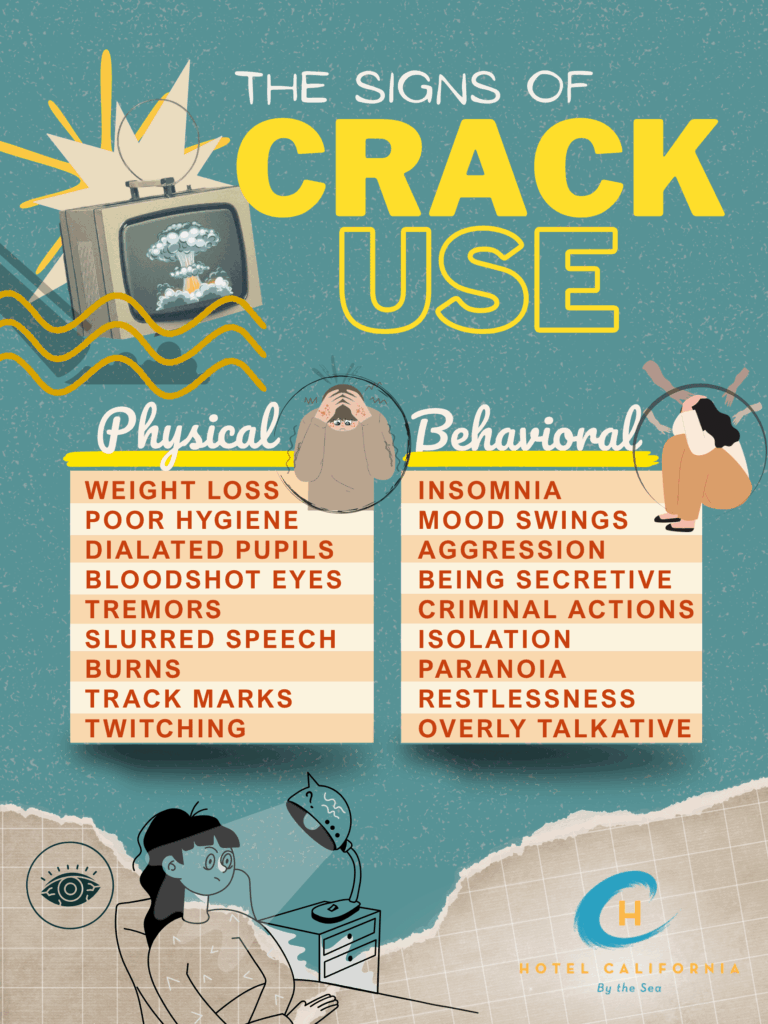What are the Signs of Crack Use?
Crack cocaine is an addictive drug. Signs of crack use are similar to those of cocaine and stimulant use. People who use crack typically exhibit a sense of overconfidence, intense happiness and hyperactivity. This is due to the immediate effects of intense euphoria and high energy. The National Survey on Drug Use and Health concluded that an estimated 4.8 million people aged 12 and older used cocaine and its various forms in 2020.

Cocaine is a potent stimulant substance. Cocaine typically comes in a white powder form that can be inhaled through the nose, rubbed into the gums, dissolved into liquid and injected or smoked. It can increase serious risk of life-threatening medical conditions like a heart attack and stroke.
The effects of cocaine are short-lived. A cocaine high can last around 20 minutes to a few hours, depending on the method of administration and the amount of the drug taken. Because of this, users usually use the drug in a binge where they continue to use the drug before fully crashing out in order to continuously experience the effects of the drug. The comedown from cocaine can be dangerous and intense to the point where users will continue to take more in order to avoid it. This is how an addiction starts.
What is Crack Cocaine?
Crack cocaine is processed or cooked cocaine. It is created by dissolving cocaine powder in water and simple baking soda. It is then boiled to separate the solids and then cooled down and cut into small shapes resembling crystallized rocks. They are usually white or tan in color. When these small pieces are heated up, they produce a crackling-like sound. The cracking sound is where the drug gets its name crack cocaine.
Crack cocaine is a more potent form of cocaine and the most addictive form. This is because the drug is usually ingested via inhalation and can enter the bloodstream more quickly and intensely. The chemicals in crack hit the brain faster and more directly, which can easily lead to dependence and cravings for the drug in order to recreate the intense euphoria sensation.
Crack stimulates the central nervous system by increasing the brain’s supply of dopamine. Excess dopamine in the brain leads to feelings of euphoria. However, the effects of crack cocaine are short-lived. They have a quick onset of effects and wear off just as quickly. A crack high can last up to 15 minutes.
Crack cocaine is easy and inexpensive to produce. It creates an immediate and intense high. However, the short-lived effects can leave the user feeling depressed and craving more, leading to abuse of the drug.

What are the Signs of Crack use?
- Dilated pupils – Because crack impacts the nervous system and a person’s iris and pupils, their eyes will look dilated. Their eyes will not be able to adjust to light as they normally do.
- Red eyes – Crack users will have bloodshot or swollen eyes.
- Extreme mood swings – Crack immediately makes a person feel euphoric and energetic. However, once the effects wear off quickly, a person’s mood can change to aggression and violence. Extreme happiness to extreme sadness.
- Restlessness and fidgeting – Crack stimulates the nervous system and can cause hands to twitch or a person to grind their teeth.
- Burned or cracked lips and fingers – These burn marks are from using hot crack pipes.
- Increased talking – Because crack is a stimulant, when a person is high on crack, it increases their talkativeness. They may also increase the speed at which they are speaking and can jump from subject matter, not making any sense about Hyperactivity – A person on crack will have more energy and causing them to become fidgety and have difficulty staying still.
- Crack Pipes – Crack is typically ingested through a smoke pipe. If a person is using crack, there will be crack pipes and other drug tools lying around in their house or personal space.
- Depression – Crack works with the brain’s reward system. Withdrawal symptoms can occur when the drug effects wear off. Because crack increases dopamine in the brain, when it is out of the system and dopamine levels are depleted, it can result in feelings of depression.
- Sleep problems – Users will experience sleep issues due to the drug’s effect of sudden increased energy. In some cases, people will forgo sleep for days, resulting in fatigue and paranoia.
- Financial loss – Spending all your money on crack can leave you in financial debt.
- No desire for food or water, resulting in poor nutrition.
- Hygiene – Poor hygiene and physical appearance.
- Neglecting responsibilities at work, school or home in favor of doing drugs.
Check Your Insurance Coverage for FREE
Find out if your insurance covers addiction treatment in minutes. We accept most insurance!
Side Effects of Crack Use
- Aggression
- Anxiety
- Increased heart rate
- Increased blood pressure
- Seizures
- Slurred speech
- Dilated eyes
- Loss of appetite
- Increased body temperature
- Nausea and vomiting
- Intense drug cravings
- Heart attack
- Stroke
- Respiratory failure
- Coke bugs
- Paranoia and hallucinations
Long-term dangers of Crack Use
Long-term abuse of crack cocaine can lead to many dangerous consequences. Crack is highly potent and very addictive. Any amount of crack use should be cause for concern. It affects the brain’s pathway in response to stress. People who abuse crack can become more sensitive to feelings of stress and struggle to remain calm. This leads to drastic mood swings, depression, irritability, psychosis, paranoia and anxiety. Long-term crack use can also lead to organ damage to the liver, lung, heart and kindey.
Other side effects can include malnutrition, severe tooth decay, risk of HIV/AIDS, risk of Hep C, increased risk of seizures, high blood pressure and damage to blood vessels.
Addiction to Cocaine
Studies on cocaine use show that an estimated 15% of people who used cocaine became addicted to the drug within 10 years. It is one of the most addictive stimulant drugs. Signs of cocaine addiction include noticeable weight loss, a constant runny nose, frequent upper respiratory infections, changes in personal hygiene and emotional changes in behaviors.
- Loss of interest in friends and family
- Being angry or impatient for no reason
- Mental health issues
- Depression and paranoia
- Signs of withdrawal symptoms
A cocaine high is very brief and short-lived. This makes users feel the need to continuously use in order to continue feeling the high and euphoria. This creates a tolerance and dependence to the drug. Once dependence creates withdrawal symptoms, signs of addiction become more apparent.
Reach out to Hotel California by the Sea
We specialize in treating addiction and other co-occurring disorders, such as PTSD. Our Admissions specialists are available to walk you through the best options for treating your addiction.
Treatment for Cocaine Addiction
Crack cocaine can become an addictive substance very quickly. How can you tell if someone is one crack? There are many signs of crack use that can be identified physically and behaviorally. Professional behavioral treatment programs such as Hotel California by the Sea provide help for those with an addiction to crack cocaine. We offer treatment at all levels of care, including detox, residential, PHP and IOP. We utilize evidence-based treatment methods such as CBT, DBT and EMDR therapy. Hotel California by the Sea is dedicated to helping clients reach their goals of sobriety and overcome their addiction.
References:
https://www.addictioncenter.com/drugs/crack-cocaine/symptoms-signs
https://my.clevelandclinic.org/health/articles/4038-cocaine-crack
https://www.addictions.com/crack/10-telltale-signs-crack-use
https://www.addictionhelp.com/crack
https://www.ascendantny.com/crack-addiction-treatment/
